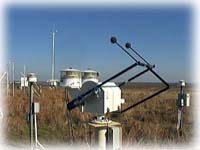
|
The ARM Project:
|
|
|
|
|
STATE GOAL 11: Understand the processes of scientific inquiry and technological design to investigate questions, conduct experiments and solve problems. |
|
Middle / Junior High School |
a |
A. Know and apply the concepts, principles and processes of scientific inquiry. |
|
|
a |
a |
|
|
11.A.3a |
Formulate hypotheses that can be tested by collecting data. |
|
|
11.A.3b |
Conduct scientific experiments that control all but one variable |
|
|
11.A.3c |
Collect and record data accurately using consistent measuring and recording techniques and media. |
|
|
11.A.3d |
Explain the existence of unexpected results in a data set. |
|
|
11.A.3e |
Use data manipulation tools and quantitative (e.g., mean, mode, simple equations) and representational methods (e.g., simulations, image processing) to analyze measurements. |
|
|
11.A.3f |
Interpret and represent results of analysis to produce findings. |
|
|
11.A.3g |
Report and display the process and results of a scientific investigation. |
|
|
a |
a |
|
|
a |
B. Know and apply the concepts, principles and processes of technological design. |
|
|
a |
a |
|
|
11.B.3a |
Identify an actual design problem and establish criteria for determining the success of a solution. |
|
|
11.B.3b |
Sketch, propose and compare design solutions to the problem considering available materials, tools, cost effectiveness and safety. |
|
|
11.B.3c |
Select the most appropriate design and build a prototype or simulation. |
|
|
11.B.3d |
Test the prototype using available materials, instruments and technology and record the data. |
|
|
11.B.3e |
Evaluate the test results based on established criteria, note sources of error and recommend improvements. |
|
|
11.B.3f |
Using available technology, report the relative success of the design based on the test results and criteria. |
|
STATE GOAL 12: Understand the fundamental concepts, principles and interconnections of the life, physical and earth/space sciences. |
|
Middle / Junior High School |
a |
C. Know and apply concepts that describe properties of matter and energy and the interactions between them. |
|
|
a |
a |
|
|
12.C.3a |
Explain interactions of energy with matter including changes of state and conservation of mass and energy. |
|
|
12.C.3b |
Model and describe the chemical and physical characteristics of matter (e.g., atoms, molecules, elements, compounds, mixtures). |
|
|
a |
a |
|
|
a |
D. Know and apply concepts that describe force and motion and the principles that explain them. |
|
|
a |
a |
|
|
12.D.3a |
Explain and demonstrate how forces affect motion (e.g., action/reaction, equilibrium conditions, free-falling objects). |
|
|
12.D.3b |
Explain the factors that affect the gravitational forces on objects (e.g., changes in mass, distance). |
|
|
a |
a |
|
|
a |
E. Know and apply concepts that describe the features and processes of the Earth and its resources. |
|
|
a |
a |
|
|
12.E.3a |
Analyze and explain large-scale dynamic forces, events and processes that affect the Earth's land, water and atmospheric systems (e.g., jetstream, hurricanes, plate tectonics). |
|
|
12.E.3b |
Describe interactions between solid earth, oceans, atmosphere and organisms that have resulted in ongoing changes of Earth (e.g., erosion, El Nino). |
|
STATE GOAL 13: Understand the relationships among science, technology and society in historical and contemporary contexts. |
|
Middle / Junior High School |
a |
A. Know and apply the accepted practices of science. |
|
|
a |
a |
|
|
13.A.3c |
Explain what is similar and different about observational and experimental investigations. |
|
|
a |
a |
|
|
a |
B. Know and apply concepts that describe the interaction between science, technology and society. |
|
|
a |
a |
|
|
13.B.3c |
Describe how occupations use scientific and technological knowledge and skills. |
Return to ARM Project Page